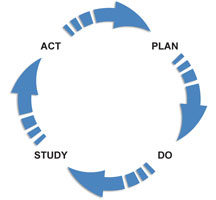 Update 2 from my pilot course on Quality Monitoring and Improvement for the Social Services: It was great fun watching social service students catch on to the idea of improvement cycles, charters, and how to know if your change is an improvement. They had not been exposed to PDSA cycles or related topics in their social service careers or in their coursework.
Update 2 from my pilot course on Quality Monitoring and Improvement for the Social Services: It was great fun watching social service students catch on to the idea of improvement cycles, charters, and how to know if your change is an improvement. They had not been exposed to PDSA cycles or related topics in their social service careers or in their coursework.
All in all I will call it a success. I will share comments from the course evaluations when I receive them.
The students proposed and worked through very interesting projects, based on work in real social service agencies and healthcare settings. Two proposed projects related to no-show rates. Two proposed projects related to welcoming social service clients to their agencies. I don't think this is accidental. Social service agencies struggle with engagement for a variety of reasons.
Here were the bumps.
The biggest challenge as a teacher was creating an improvement project assignment of the right scope. Improvement happens iteratively, in cycles, each with its own charter and measurement plan and outcome. My original assignment called for learners to write a charter for a cycle at least three cycles in, while providing results from prior cycles as justification for the direction of the current cycle. This was confusing for students. How far back should they go and how far forward should this current cycle go? When I do it all again, I think I will require charters and A3s (one page results summaries) for two prior cycles, plus a charter for the third cycle. It this is confusing to you, rest assured it was confusing for the students when first exposed.
The second challenge was to push students on how to learn much more quickly whether their improvement is resulting in change. Students tendency was to wait until the next survey opportunity or administrative data review, which was usually months down the road. This is what I found myself saying over and over. "What can you do tomorrow to know whether this is working? Who can you talk to? What can you learn from today's effort?"
Michael Cull, who teaches QI to folks in Tennessee, told me the biggest challenge he has is getting teams to pick a remedy and try. From this class, I began to see that this might be how a QI consultant might help most. The iterative cycles of QI require someone to be pushing for progress: to pick a remedy, to try it out even if it is not yet perfect, to learn quickly how to adjust the effort, to try again. The QI Pusher.
The best possible outcome, I think, is that several students caught the excitement of being able to improve things, even when the improvements were faked. They could see how the steps they took established baseline, described processes, understood who the customers were, explored causes, picked the major drivers of the problem, used a variety of mechanism to discuss and pick solutions (we used some six hat stuff) and figured out what data they needed to know if they had made a change.
